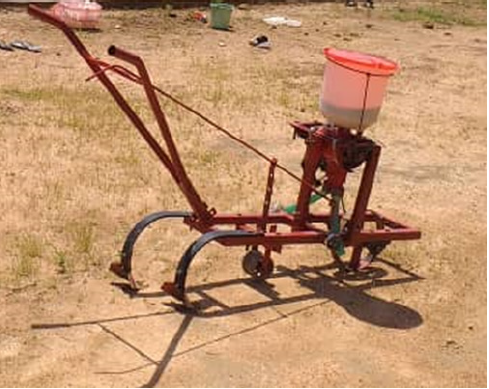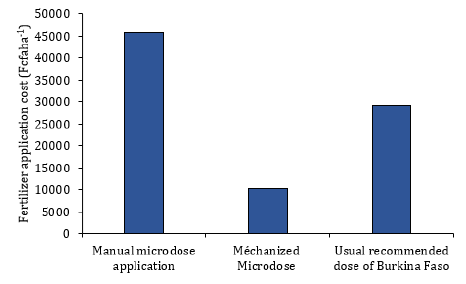- Submissions

Full Text
Academic Journal of Engineering Studies
Evaluation of NPK Microdose Fertilizer Applicator on Sorghum in Burkina Faso
Barro Albert1*, Compaoré Emmanuel1, Simporé Saidou1 and Meda Inganc2
1INERA (Institute for the Environment and Agricultural Research), DRREA du Center, BP 10 Koudougou, Burkina Faso
2Institut de Recherche en Sciences Appliquées et Technologies (IRSAT) 03 B.P. 7047 Ouagadougou 03
*Corresponding author: Barro Albert, INERA (Institute for the Environment and Agricultural Research), DRREA of Center, BP 10 Koudougou, Burkina Faso
Submission: July 26, 2021 Published: August 26, 2021
.jpg)
ISSN:2694-4421 Volume2 Issue3
Abstract
Agricultural production in Burkina Faso is low partly because of low and irregular rainfall, but also because of poor soil fertility. This low soil fertility, linked to the nature of the soils, which are generally ferric lixisol, is exacerbated by the fact that farmers add very little or no fertilizer to their plots. The solution of micro dosing granulated fertilizer was beneficial for producers but the time taken for its manual application was an obstacle to its dissemination. The animal traction micro dose fertilizer applicator is evaluated at the Saria station to determine its effectiveness. The crop is sorghum and three treatments are compared: Manual micro dose application of NPK granular fertilizer; mechanized application of the micro dose of granular NPK fertilizer and of the conventional dose of granulated NPK fertilizer. The experimental design was a randomized blocs on three-replication. The labor times and the grain and straw yield of the sorghum are measured. The analysis of variance and the comparison test performed make it possible to distinguish the production of plots of micro dose 588kgha-1 (manual or mechanized) from that of the conventional dose of 751kg.ha-1. The cost calculation of the practice used in the plots shows that the working time for the mechanized practice is 7h.ha-1 while the manual practice of the application of fertilizer is 27h.ha-1. The consequence is that for the costs invested in technology yield 4.1. The franc invested in the manual practice of the micro dose brings only 2.0 francs and for the conventional method 2.6. The promotion of the micro dose fertilizer applicator therefore appears useful in improving productivity in a Sahelian country such as Burkina Faso.
Keywords: Agricultural mechanization; Manual fertilizer application; Micro dose applicator; Sorghum; Labor cost; Burkina Faso
Introduction
Burkina Faso has a relatively low agricultural production because of the low yields obtained especially in the fields of small producers. Faced with changes in climate parameters in the sub-region and particularly in Burkina Faso, proven practices and strategies could be useful to ensure substantial agricultural production for a population experiencing strong demographic growth 3.1°⁄ₒₒ. Burkina Faso is however one of the Sahelian countries with a predominantly semi-arid climate which faces relatively difficult agroecological conditions due to its climate and increasing human pressure. This low yield is linked to several factors, including low soil fertility. The work carried out by Bationo A et al. [1], AGRA [2], Barro A et al. [3] show that the micro dose is a solution to increasing yields. The equipment evaluated is a tool for the application of granulated mineral fertilizer in micro dose to sorghum. Tests planned in three regions were only carried out in the central region despite the availability of equipment in all three regions.
Materials and Methods
The study site
The experimental field was at Saria Agricultural Research Station in Burkina Faso (12°16 N, 2°9 W, 300m altitude), characterized by a north-Sudanic climate [4]. The average annual rainfall was 800mm. Rainfall is mono-modal, lasts for 6 months (May-October) and is irregularly distributed in time and space. Mean daily temperatures varied between 30 °C during the rainy season to 35 °C in April and May. The evaluation was carried out on a Ferric lixisol with 100cm deep [5].
The tool description
The equipment used was a simple animal (donkey, oxen; horse, etc.) traction tool (Figure 1). The fertilizer used was granular NPK (14 23 14).
Figure 1: Animal draft NPK fertilizer micro dose applicator.

The crop
The plant material used in this study was the variety Kapèlga of sorghum [6]. It is an improved local variety with white grain and short cycle (90 days), disseminated by in Burkina Faso.
The experimental design
The experimental design was a randomized Fisher bloc with three plots of 15m x 30m or 450m² and three replications (Figure 2). The sowing is done at spacings of 40cm between pockets and 80cm between rows. NPK 14 23 14 fertilizer costs 18,500 F CFA per 50kg bag. Sorghum grain is sold 152 F CFA kg-1 and straw at 30 F CFAkg-1. The labor cost was 187.5 F CFAh-1. The cost of the tool is 4000 F CFAha-1 [7]. The manual micro dose NPK fertilizer was apply at the rate of 62.5kgha-1. Mechanized micro dose was apply at the same rate. The usual recommended dose of Burkina Faso for NPK on sorghum is 100kgha-1.
Figure 2: Experimental design (One replication).

Data collection and statistical analyze
Sorghum grain and straw yields were measured annually at harvest from the center two rows to avoid edge effects. Rainfall was measured and collected daily at a weather station. Economic analysis was done with 130 West African CFA franc (CFA) kg-1 (i.e., 0.22 USD) for sorghum grain and 30 CFAkg-1 (i.e., 0.05 USD) for sorghum straw. The USD to CFA conversion rate used was 1:600. Data analysis was conducted using ANOVA in XLSTAT software XLSTAT Version 2016.02.28451. A Newman-Keuls test was used for mean separation at α= 0.05.
Results
Labor time
The lower labor time is observed on the plot of mechanized fertilizer application. The manual application of fertilizer needs more labor time (Table1).
Table 1: Labor time measured during fertilizer application on plots.

Sorghum yields
The results of the grain yield analysis are shown in the graph in Figure 3. The conventional rate produces the best yield of 752kgha- 1. The manual micro dose and the mechanized one has the same level of grain yield (560 to 589kgha-1). There is therefore a significant difference between the production on the conventional plot and that of the micro dose plots with a probability less than 0.0001. The low level of yields is due to the fact that the sowing was late (July 10) due to insufficient rains at the start of the season. Analysis of straw yields shows the same trends. Manual and mechanized micro dose application induces the same yields (Figures 3 & 4).
Figure 3: Sorghum grain yield.

Figure 4: Sorghum straw yield.

Discussion
Comparative cost of sorghum production
The cost of fertilizer application operations is shown in the graph in Figure 3 below. The manual micro dose comes to 45,000 CFA francs ha-1. This cost considers that for the application of the manual micro dose the producer performs a weeding before applying the NPK fertilizer. This practice is followed by the applying the conventional dose which is 36% lower than that of the manual micro dose. The reduction in the cost of the application by the equipment is 77% compared to manual practice. This decrease in cost is due to the fact that the applicator performs the weeding simultaneously during the fertilizer application.
Table 2 below shows the ratio of the value of the gain linked to the technology to its cost. This is calculated with regard to the costs obtained on the graph of Figure 5 and the grain and straw yields obtained on each treatment. The highest value is given by the mechanized practice of the micro dose of which each franc invested in technology brings in four times more. For the manual micro dose, it reduces the cost of the fertilizer applied because the quantities are smaller but because of the high-working time it does not allow for significant financial gain. This practice is quicker and more efficient that the JAB planter used evaluated by Aikins SHM et al. [8]; Figure 6.
Table 2: Variation of the ratio value/cost.

Figure 5: Fertilizer application cost.

Figure 6: Plot of sorghum kapèlga variety with mechanized micro dose on the right (a) and conventional dose on the left (b) during the flowering period (Saria September 2020., photo A. BARRO).

Conclusion and Perspectives
This year, due to the delay in starting the campaign, the level of yield is quite low. But despite this weakness it is clear from the test carried out in Saria on sorghum that the use of the micro dose applicator makes the practice of the micro dose twice as profitable. This result confirms the observations made by Ouédraogo J [7] in 2020 on sorghum in the Kindi regions. Assessment tests in the regions of Fada and Bobo Dioulasso could not be carried out. To refine the effect of the mechanized technique in other production conditions. We want to have more varied conditions and development actor for real-world testing during this 2021 campaign [9].
Acknowledgement
We would like to thank INERA, IRSAT and the Smallholder Agricultural Productivity Improvement Program for Sub-Saharan Africa Project (SAPEP) for funded this initiative.
References
- Bationo A, Waswa B, Abdou A, Bado BV, Bonzi M, et al. (2012) Overview of long-term experiments in Africa. In Lessons learned from long-term soil fertility management experiments in Africa. In: Bationo A, Waswa B, Kihara J, Adolwa I, Vanlauwe B, et al. (Eds.), Springer, Germany, pp. 1-26.
- AGRA (2014) Achieving pro-poor green revolution in dry lands of Africa: Linking fertilizer micro dosing with input-output markets to boost smallholder fanners' livelihoods in Burkina Faso. Final report AGRA-Microdose Project, p. 72.
- Barro A, Compaoré E, Simporé S, Zeba A, Ouédraogo J (2019) Granular fertilizer micro-dose application device. Post on the mechanization of the micro-dose. INERA, CNRST, IRSAT, Ouagadougou, Burkina Faso.
- Fontes J, Guinko S (1995) Map of vegetation and land use in Burkina Faso, explanatory note, French Ministry of Cooperation, Toulouse, France, p. 67.
- FAO-UNESCO (1994) Soil Map of the World. ISRIC, Wageningen, p. 140.
- Sorghum bicolor, Vigna unguiculata and producers' incomes. Material Report 2, Integrated Natural Resource Management (IRMR). UNB Bobo Dioulasso, p. 4.
- Ouédraogo J (2020) Mechanization of microdose application of granular fertilizer: Effect on sorghum
- Aikins SHM, Bart-Plange A, Opoku-Baffour S (2010) Performance evaluation of jab planters for maize planting and inorganic fertilizer application. ARPN Journal of Agricultural and Biological Science 5(1): 29-33.
- Zougmoré R, Ouattara K, Mando A, Ouattara B (2004) Role of nutrients in the success of soil and water conservation techniques (stone bunds, grass strips, zaï and half-moons) in Burkina Faso. Science and Planetary Changes/Drought 15(1): 4-8.
© 2021 Barro Albert. This is an open access article distributed under the terms of the Creative Commons Attribution License , which permits unrestricted use, distribution, and build upon your work non-commercially.
 a Creative Commons Attribution 4.0 International License. Based on a work at www.crimsonpublishers.com.
Best viewed in
a Creative Commons Attribution 4.0 International License. Based on a work at www.crimsonpublishers.com.
Best viewed in 







.jpg)






























 Editorial Board Registrations
Editorial Board Registrations Submit your Article
Submit your Article Refer a Friend
Refer a Friend Advertise With Us
Advertise With Us
.jpg)






.jpg)














.bmp)
.jpg)
.png)
.jpg)










.jpg)






.png)

.png)



.png)






